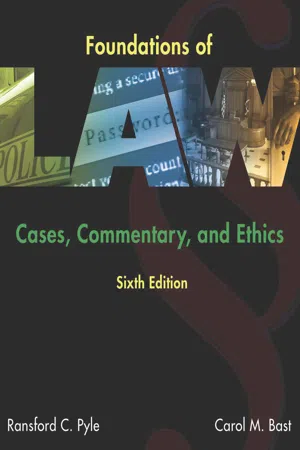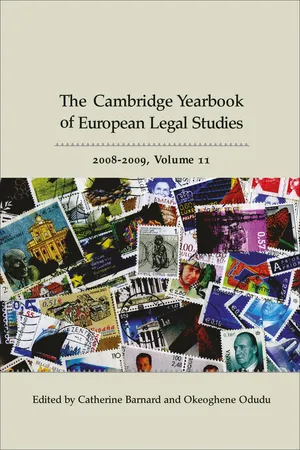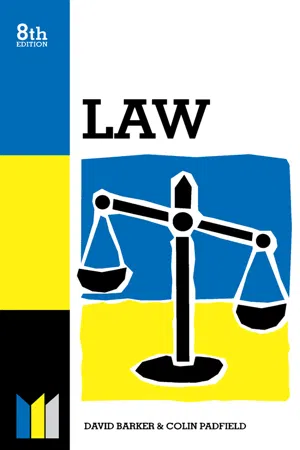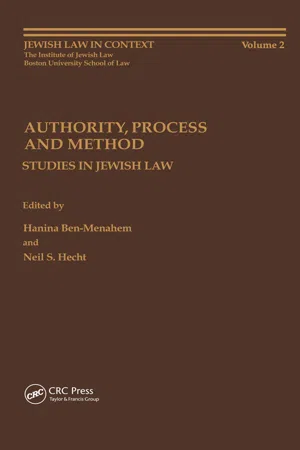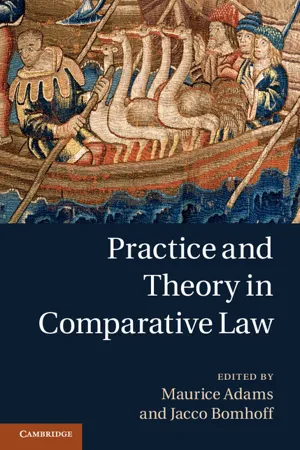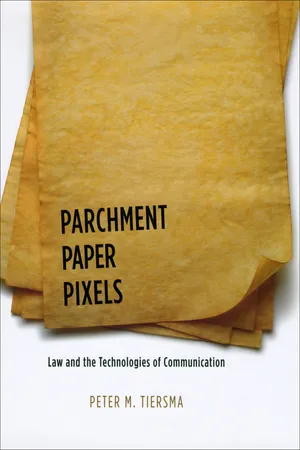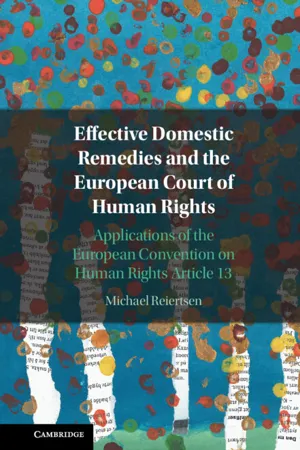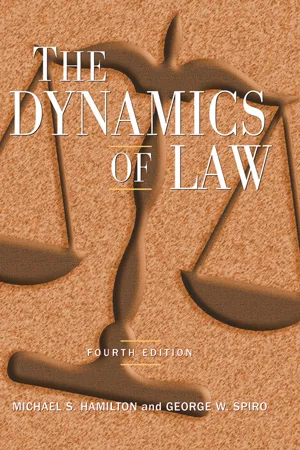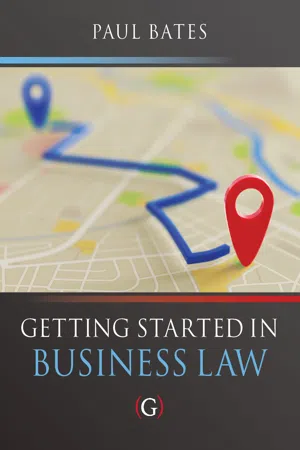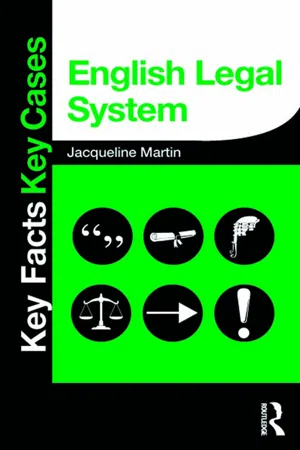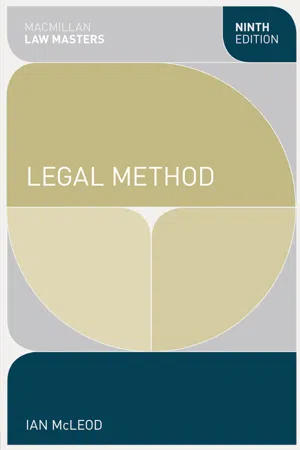Law
Case Law
Case law refers to the body of legal decisions made by judges in court cases. These decisions establish precedents that can be used to interpret and apply the law in future cases. Case law plays a crucial role in shaping and evolving the legal system, as it provides guidance and clarity on how laws should be interpreted and enforced.
Written by Perlego with AI-assistance
Related key terms
1 of 5
12 Key excerpts on "Case Law"
- Frederick L. Morton(Author)
- 2002(Publication Date)
- University of Calgary Press(Publisher)
Precedents, Statutes, and Legal Reasoning One of the most distinctive characteristics of the judicial process is its for-malized method of reasoning. Because their authority flows from the public perception that they are merely applying pre-existing rules to resolve new disputes, judges are not permitted the broad prerogative enjoyed by the legislative and the executive branches. Unlike the latter, courts are not supposed to create new policies to deal with new problems. In their oral or written judgments, judges must explain where and how they derived the rule used to settle a case. There are three principal sources for these rules: a written constitution, legislative statutes (including admin-istrative regulations), and prior judicial decisions, known as precedents. Constitutional interpretation is the subject of the following two chapters. This chapter is concerned with the role of precedent and statutory interpre-tation in judicial reasoning. Until the middle of the nineteenth century, most internal or domestic law in English-speaking societies was common law. Common law originated in the judicial recognition and enforcement of traditional usages and customs of the Anglo-Saxon and later Norman peoples in the British Isles. As these judicial decisions were made, they in turn became part of the common law. The common law in contemporary Canadian society consists of all previous judicial decisions by Canadian and British courts, as they are recorded in the case reports of these nations. The common law system is distinguished from the Civil Law system by its basis in precedent rather than legislative enact-ment. The Civil Law system originated in ancient Roman law, developed on the European continent, and was imported into Quebec by the French. It is based on a single, comprehensive code, enacted by the legislature. The law of precedent, or stare decisis, is a self-imposed judicial rule that like cases be decided alike.- eBook - PDF
Foundations of Law
Cases, Commentary and Ethics
- Ransford Pyle, Carol Bast(Authors)
- 2016(Publication Date)
- Cengage Learning EMEA(Publisher)
In this way, the first case is precedent for the second. If the rule is applied in many similar cases over a period of time, the court is likely to refer to it as a “well-established principle of law.” The force of a precedent depends upon the court that hands it down. A precedent is con-sidered binding on the court that sets it and all lower courts within its jurisdiction. In a typical state court system, decisions can be rendered at three levels: trial court (lowest), court of appeals (intermediate appellate), and state supreme court (highest). Decisions of the highest state court are binding on all state courts. Decisions of courts of appeals are binding on that court and on lower courts within its jurisdiction. There is frequently more than one court of appeals, each with specific regional jurisdiction within the state. The hierarchy of federal courts also follows this pattern. It sometimes happens that different courts of appeals within the same system (i.e., a state or the federal system) will formulate different rules for the same fact situation, creating considerable confusion. Trial courts in the First Circuit may feel bound by a different rule than those in the Fifth Circuit, and courts in the Third Circuit, whose court of appeals may not have privity of contract The relationship between two parties to a contract. Originally, this was a bar to a suit brought by a consumer against a manufacturer when the consumer bought through a dealer rather than directly from the manufacturer. Modern product liability law does away with this impediment. precedent Prior decisions of the same court, or a higher court, which a judge must follow in deciding a subsequent case presenting similar facts and the same legal problem. Precedent consists of the rule applied in a case and encompasses the reasoning that requires it. - Catherine Barnard, Okeoghene Odudu, Catherine Barnard, Okeoghene Odudu(Authors)
- 2009(Publication Date)
- Hart Publishing(Publisher)
First, most defini-tions of holding and dicta focus on the context of a case before the deciding court to determine the binding element of the decision. Secondly, the distinc-tion enables subsequent courts to moderate the originally expressed rule, again, with reference to the context of the case before the deciding court. (ii) Context of the Case Various reasons are offered to explain why the context of the case matters for determining the extent to which a previous decision should be followed. Austin seems to believe that the case—a real-life situation—gives a judge special insight, as we have seen above. This view is prevalent in much of the Supreme Court’s Case Law and is not limited to questions of precedent. In Valley Forge v Americans United for Separation of Church and State the Court stated that ‘a concrete factual context [is] conducive to a realistic appreciation of the consequences of judicial action’. 62 Another reason for making a case relevant for determining holdings is a desire to constrain judicial lawmaking activity. If creating law is only a corollary to the courts’ main task—deciding disputes—then law creation will only occur in the con-text of deciding disputes before them. This conclusion relies on an assump-tion that it is the primary role of the Supreme Court to decide disputes. To a great extent it is still Marbury v Madison 63 that shapes the vision of what the Supreme Court should be doing, apart from the textual limi-tations of Article III of the US Constitution. 64 There are two conflicting views: the dispute resolution (or private right) model on the one hand and the public rights model on the other. 65 The former reflects the traditional conception of adjudication as the resolution of disputes between two par-ties and enforcement of their rights. It is characterised thus by Marshall in Marbury : ‘the province of the Court is, solely, to decide on the rights of individuals’.- eBook - PDF
Law
Made Simple
- D. L. A. Barker, C. F. Padfield(Authors)
- 2014(Publication Date)
- Made Simple(Publisher)
Frequently there will be no relevant decided case for a judge to turn to. Notwithstanding the many volumes of law reports and the thousands of cases reported, representing a 'wealth of detailed rules', there may be no certainty of the rule to be applied. The judge must declare what the rule should be by arguing from analogous cases. Since the common law is 'complete' and capable of providing a remedy for every wrong, where there is no apparent rule the judge is expected to act creatively in declaring from his study of the common law or equity or jurisprudence what that rule should be. Obviously no two cases coming before the courts of law are identical. This fact enables a judge to point to some material difference which justifies him in refusing to apply a rule of law previously laid down. The judge is distinguishing the present case from the earlier one, so avoiding hardship or injustice which was not envisaged when the earlier judgment was announced. After hearing the evidence from both sides in a case and the address of counsel, the stage is reached when the judgment is delivered. The form the judgment takes is generally as follows: (a) A statement of the relevant facts. (b) Review of relevant precedents. (c) Reasoning of the judge from one or more of the cases cited. (e) Judgment, decree, or order made. The judicial precedents which we have been considering above are found in law reports. Law Reports The records of Anglo-Saxon laws (or dooms) and of actual cases are few. Similarly, we have scant records of cases in the Norman period, and we have to remind ourselves that the common law was not completely formed until around A.D. 1250. The first treatise on the English common law was written by Henricus de Bracton, who lived in the first part of the thirteenth century in the reign of Henry HI. His work, in part a collection of cases, became the forerunner of the later law reports and was entitled De legibus et consuetudinibus Angliae. - eBook - PDF
- Hanina Ben-Menahem, Neil S. Hecht(Authors)
- 1999(Publication Date)
- CRC Press(Publisher)
4 AUTHORITY, PROCESS AND METHOD from common law, which was generated from rulings inductively on a case by case basis.12 In Case Law of this kind, facts create the law -ex facto oritur ius. English law is the model of stare decisis,13 law distinguished by consis tent and stable rulings. The English system spread to all the countries where common law is prac ticed, and today the principal feature differentiating English and American law from other modem legal systems is the decisive influence of precedent in shaping the law.14 Cardozo noted that “stare decisis is at least the everyday working rule of our law.”15 There has been much discussion recently in the United States about weakening the principle of binding precedent, but it still has a strong hold on the American judicial system.16 3. Precedent in Israeli Law During the British Mandate period, the doctrine of binding precedent was adopted by the courts in Mandatory Palestine as a matter of course, both with regard to precedents set by local courts, and those set by British courts. The principle of binding precedent became part of the legal system by force of article 46 of the Palestine Orders in Council 1922-1947. Though not without misgivings, this state of affairs continued after the establishment of the State of Israel, until a bench of five judges handed down a supreme court ruling formally adopting the principle of binding precedent in its entirety.17 This ruling was later interpreted as follows: “It is clear and beyond doubt that the court unconditionally upheld English law in the matter of the binding power of precedent.”18 A lone dissenting opinion, opposed to the absolute nature of the ruling, was rejected.19 12 Allen, op. cit., pp. 161-162. 13 J. Salmond, op. cit., (note 11 above), esp. pp. 174ff. 14 Edwin W. Patterson, Jurisprudence (New York: 1953), p. 300. 15 Benjamin N. Cardozo, The Nature of the Judicial Process (New Haven: 1921), p. - eBook - PDF
- Maurice Adams, Jacco Bomhoff(Authors)
- 2012(Publication Date)
- Cambridge University Press(Publisher)
I will deal with them in the following section. Conceptual distortions: ‘Case Law technique’, ‘sources of law’ and ‘bindingness’ As I noted earlier, the theoretical study of precedent, at least in the English language, is dominated by its common law understanding. The common 27 See e.g. Archives de philosophie du droit, 30 (1985), devoted to jurisprudence, or Archives de philosophie du droit, 50 (2007), focused on judicial lawmaking (la cr´ eation du droit par le juge). 28 Lasser, Judicial Deliberations. 29 Apart from Lasser, Judicial Deliberations, see particularly J. P. Dawson, The Oracles of the Law (Ann Arbor: The University of Michigan Law School, 1968), and John H. Merryman, ‘The French Deviation’, American Journal of Comparative Law, 44 (1996), 109. reasoning with previous decisions 57 law tradition’s ‘Case Law technique’ seems to be missing in the civil law tradition, which is sometimes commented on with scorn. 30 Not to have the common law precedent simply means not to have precedent at all – and this applies to the Court of Justice’s precedent too. 31 The common law Case Law technique seems to be viewed as the only possibility – also by some comparative lawyers on the continent. For example Martijn Hesselink talks with suspicion of the way in which Case Law is being taught in the civil law tradition, a way similar to the code. What the student should look for is the abstract rule which the courts formulate (attendu de principe, massima), quite similar to a rule in the code. And even if in the particular case the court of first instance, the court of appeal, the Advocate-General and the annotator have said something different, what the highest court has said is the law. Frequently students are told that they do not have to know the facts of the case. They rather have to learn what place the case has in the system. Each case is presumed to fit within the system; the question is only how. - eBook - PDF
Parchment, Paper, Pixels
Law and the Technologies of Communication
- Peter M. Tiersma(Author)
- 2010(Publication Date)
- University of Chicago Press(Publisher)
118 There were certainly disputes and rivalries between the courts, but following precedent did not normally involve one court imposing its will upon another. Instead, precedent consisted of the notion that once the royal judges decided an issue in a particular way, they and their colleagues should decide that issue in the same way in future cases. Precedent was a matter of judicial economy (not having to relitigate a question), fairness (parties in different cases would be treated the same), and predictability. This aspect of precedent, as noted earlier, is generally referred to as stare decisis . American courts, in contrast, were organized hierarchically virtually from the beginning. The typical system is for a state to have trial courts, whose decisions can be reviewed by courts of appeal. Decisions by the courts of appeal are subject to discretionary review by the state’s supreme court. Trial judges are not usually bound by the decisions of other trial judges, nor are they necessarily bound by their own previous decisions. For the most part, only opinions written by appellate judges can function as precedent. 119 As we have already discussed, precedent has come to mean not just that judges, as a policy matter, should normally follow their own previous deci-sions (stare decisis or horizontal precedent), but that in addition lower courts must follow the decisions of judges above them (vertical precedent). Once there is a clear hierarchy of courts, the word of the higher courts—in particular, the written word—is law. Thus, it is fair to say that by the middle of the nineteenth century, a distinct American notion of precedent and of common law decision mak-ing was beginning to form. The profession was no longer adhering to the notion that judges merely declared the common law. Rather, judges could establish principles and rules for deciding cases in their opinions. These opinions had to be in writing. Case reports contained the exact words of the judges. - eBook - PDF
Effective Domestic Remedies and the European Court of Human Rights
Applications of the European Convention on Human Rights Article 13
- Michael Reiertsen(Author)
- 2022(Publication Date)
- Cambridge University Press(Publisher)
Moreover, in the few cases where the Court has taken a principled stand, it has primarily done so to limit the scope of application, for instance, by linking the 50 See, for example, Scoppola v. Italy (no. 3) (Grand Chamber 2012) para. 94. 51 See, for example, Jacob (2011) 1024. 52 The possibility of deviating from precedent is a major difference between judge-made law and legislation; see, for example, Raz (2009) 195. 53 See, for example, Pellonpää (2007) 409, and, more generally, for example, Barak (2016) 31. 54 Raz (1998) 177. 55 Compare Venzke (2012) 48–49. 56 Similarly, for example, Keller and Sweet (2008) 7–8; Venzke (2012) 137. 23 Analysis and Selection of Case Law notion of arguability to the notion of manifestly ill-founded (primarily applying a contextual canon of interpretation), 57 and by excluding the right to challenge legislation as such (primarily applying a historical canon of interpretation – the assumed will of the drafting fathers). 58 But nothing in the legal method, including the legal context and precedent of the Court, prevents the Court from departing from its former Case Law concerning these questions, which I, in some cases, argue that the Court should do (e.g., in Sections 7.3.3 and 10.5.3 ). 2.5 THE WIDER PRECEDENTIAL EFFECTS OF THE COURT’S Case Law Even though judgments of the Court, according to Article 46(1) of the ECHR, are only formally binding on the parties and, therefore, have no formal erga omnes effect, 59 they function as normative guidance to other Member States and actors affected. 60 And democracies and the Council of Europe are based on a deeply rooted notion of equality, which leads to the expectation that like cases are dealt with alike. 61 States that wish to promote equality and avoid being judged by the Court, therefore, implement and follow the Case Law of the Court, even if such judgments are not formally binding. 62 This poses at least three problems concerning how the Court could con- strue and apply Article 13. - eBook - ePub
- Michael S Hamilton, George W Spiro(Authors)
- 2014(Publication Date)
- Routledge(Publisher)
CHAPTER 4Judicial Lawmaking ILaw Built on PrecedentsWhen do judges make law? They do so every time they decide a case that no existing rule quite fits. They also make law when they determine what rule applies to a case and when they interpret or construe a statute or a constitutional provision (discussed in Chapters 6 and 7 .) They make law when, in the absence of either an applicable legislative rule or a directly controlling precedent, they have to create a rule by building on precedents established in analogous cases. This chapter is about judicial lawmaking by building on precedents.Nowadays most major innovations in legal rules are introduced by legislatures, and much of the work of judges consists of interpreting legislative rules. But this has not always been so. In the early centuries of the legal tradition we share with England, legislative lawmaking was comparatively unimportant; most lawmaking was the work of judges building on precedents. Indeed, in some fields—contracts, for instance—the rules even to this day are primarily of judicial origin.THE COMMON-LAW TRADITIONWhen the Normans conquered England in the eleventh century, they found a land with no nationwide, systematized body of law. Such law as existed was essentially a formalization of local custom. In an effort to unite the country under their rule, early Norman kings sent royal judges out into the land to adjudicate disputes and accusations brought before them by the people. Royal justice dispensed by these judges was firm but generally fair, inexpensive, and expeditious. By the beginning of the thirteenth century, it had wholly displaced the patchwork of Anglo-Saxon institutions that had prevailed before the Norman Conquest.Since royal judges had no body of generally accepted rules on which to base their decisions, they had to create rules as they went along. Understandably, they drew heavily on the traditions, customs, business practice, and moral standards of the people. But they also relied on their own judgment, their sense of justice, and their notions of the community’s needs. The body of rules that thus evolved came to be known as the common law - eBook - PDF
- Paul Bates(Author)
- 2021(Publication Date)
- Goodfellow Publishers(Publisher)
For the sake of political correctness, I’m sure, some writers are now referring to the court system as being split into ‘senior courts’ and ‘subordinate courts’. Whatever the words used, the system is the same. Getting Started in Business Law 28 In general, the lower courts have to follow the judgements made by higher courts. That is, precedents set by the higher courts must be followed by courts lower down in the system. Points of law Points of law are questions of law which need to be clarified. This means that a court when hearing a case may need clarification on what the exact law is on a particular issue. Remember that these are purely issues of law (and not questions of fact, i.e. what actually happened in each case), which need explanation. These opinions are given by a higher court at the request of a lower court. Case stated An appeal by way of case stated is an appeal from a magistrate or a tribunal which goes directly to the High Court (Queen’s Bench Division). This can occur where you think that a magistrate (or a tribunal) have acted over and above their powers or jurisdiction in hearing your case. There are very few of these types of appeals. Some useful terminology Prima facie This is a bit of Latin which is very useful and is used throughout the law as it is in ordinary English usage. It simply translates as ‘at first sight’ or ‘at first appearance’. An example of its use in law would be, “ prima facie this problem looks like a case involving reckless driving”. What you mean here is that your first impression is that the case involves reckless driving but you’ve covered yourself by the use of the phrase by sug-gesting that if greater investigation is made into the case it may turn out to be some other offence. It’s also a very handy way of covering yourself if you’re asked an awkward question in a seminar. Stare decisis – Let the decision stand This Latin expression is the basis of the operation of the above system of prec-edent. - eBook - ePub
- Jacqueline Martin(Author)
- 2014(Publication Date)
- Taylor & Francis(Publisher)
2 Judicial precedent2.1 The doctrine of precedent2.1.1 Stare decisis1 It is a fundamental principle that like cases should be treated alike.2 The Latin maxim stare decisis (stand by decisions of past cases) is the basis of the doctrine of precedent.3 Precedent, as operated in the English legal system, requires that in certain circumstances a decision on a legal point made in an earlier case MUST be followed.4 The doctrine is that:• all courts are bound to follow decisions made by courts above them in the hierarchy; and• appellate courts are normally bound by their own past decisions.5 An extreme example of this was seen following the decision in2.1.2 Original precedentRe Schweppes Ltd’s Agreement (1965), in which one judge in the Court of Appeal dissented. Later on the same day, when the same point of law was involved in a second case (Re Automatic Telephone and Electric Co Ltd’s Agreement (1965)), that judge said he was now bound to follow the earlier decision.1 Where there is no previous decision on a point of law that has to be decided by a court, then the decision made in that case on that point of law is an original precedent.2 Usually, when faced with the situation of having to form an original precedent, the court will reason by analogy. Cases that are nearest to it in principle will be considered, though they are not binding. If there is any parallel, the court may decide that the same type of principle should apply (Hunter and others v Canary Wharf Ltd and London Dockland Development Corporation (1995)).3 - eBook - PDF
- Ian McLeod(Author)
- 2020(Publication Date)
- Red Globe Press(Publisher)
More particularly, it will be apparent that there is a constant tension between the separation of powers (see page 71), which allows judges sufficient independent discretion to interpret and apply the law on a case-by-case basis, and the rule of law (see page 61), which requires that people should be able to predict the legal consequences of their conduct with some degree of certainty. Although the attainment of both these objectives may be thought to be desirable, it is nevertheless obvious that there is a significant extent to which they are mutually inconsistent. In other words, a balance must be struck. Thirdly, this Part will conclude by considering the practice of the European Court of Justice with regard to precedent. This material is useful not only as a necessary foundation on which to study European Union law in its own 8.1 8.2 Legal method 126 right, but also because a comparative perspective may prompt lawyers in any jurisdiction to question their own system when they see how others tackle the same problems. A wide view of precedent The idea of precedent may be formulated in a relatively wide way, by simply saying that it is desirable that similar cases should be decided in a similar manner. This wide view of precedent is based partly on the proposition that consistency is an important element of justice; partly on the fact that the practice of following previous decisions results in improved efficiency, because points of law which have once been decided can simply be applied subsequently, without being subject to repeated re-argument; and partly on judicial comity. (Judicial comity simply means the mutual respect which judges have for their colleagues.) It is not surprising, therefore, that the courts in any developed legal system are likely to follow precedent to a significant extent. Certainly there is nothing peculiarly English about such a practice.
Index pages curate the most relevant extracts from our library of academic textbooks. They’ve been created using an in-house natural language model (NLM), each adding context and meaning to key research topics.

